Understanding Intel's Dynamic Power and Thermal Framework 8.1: Smarter Throttling
by Joshua Ho on August 21, 2015 8:00 AM EST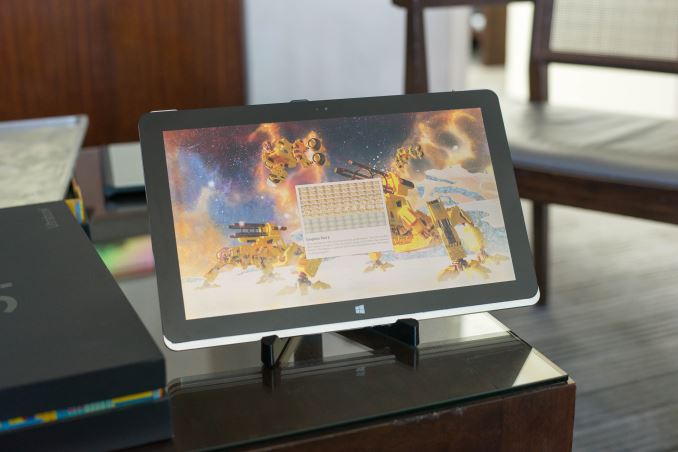
In mobile, thermal throttling is effectively a fact of life as modern, thin tablets and smartphones leave little room for implementing high-performance fans. We can use CMOS scaling to try and reduce the amount of power consumption, but in order to keep up with increasing performance demands it’s important to also scale performance as well.
This means that while performance per watt will increase from generation to generation thanks to manufacturing and architectural improvements, finding ways to allow CPUs to use more power is also part of the equation in order to get the best possible performance out of a passively cooled device. This has been evidenced in recent years by the ever-increasing dynamic power ranges for mobile CPUs, which has seen idle power consumption drop while maximum load power consumption has risen.
By increasing the dynamic range of these CPUs, it has allowed manufacturers to further optimize their devices for workloads that require high CPU performance for only short periods of time, a surprisingly common workload. For the end user then, there’s a clear benefit to both effective turbo and thermal management, as any kind of race to sleep workload sees benefit from turbo clocks, while long-running high-load workloads benefit significantly from smart thermal management.
Although Intel’s Dynamic Platform and Thermal Framework (DPTF) 8.1.x has been out for months now, these features haven’t really received much attention so far. For those that are probably unaware of what Intel’s DPTF is, it’s effectively Intel’s solution to managing throttling in a smart manner according to the TDP limits of the device based upon thermal sensors and power monitoring for x86 tablets, 2-in-1s, and PCs in general. If you think this sounds a lot like ARM’s Intelligent Power Allocation in some ways, you’d be right.
For the most part, previous iterations of DPTF have been pretty standard in the sense that they rely on a fixed correlation between temperature sensors and critical values like Tskin max and Tjunction max of all chips on the board. As these devices are unable to directly read skin temperatures, the system must instead infer what Tskin should be. And once certain temperature sensors read out certain values, the system assumes that the skin temperature has reached a maximum value, which means it’s necessary to begin throttling the system. Similarly, if an on-die chip sensor reads a specific value that is close to the maximum junction temperature, the system will react by throttling appropriately.
However in the case of DPTF 8.1, this system has changed. Instead of a fixed correlation, the system is now adaptive depending upon a number of factors. One of the key examples cited is device orientation, as how a device is placed has a significant impact on its ability to cool itself. For example, when a tablet is placed flat on a table with the display up, the back of the tablet is unable to rely on convection and ambient air flow to cool the back cover. With previous iterations of DPTF, this worst-case style setup was what was used to determine how to correlate temperature sensors with skin temperatures.
The problem with that approach was that when the device was placed in a situation where cooling was better, such as held vertically in the air or held in a dock with a circulation fan, DPTF wouldn’t change the temperature sensor correlations to skin temperature. This meant that in long run TDP-gated situations that the device was throttled to a greater extent than truly necessary.
It turns out this one change has enormous effects on performance in these thermally limited situations. With a vertical orientation, heat dissipation and thereby power headroom increases by 66%. With an active cooling dock, power headroom increases by 97%. As Intel reasons and as their data backs up, there are clear benefits in not being conservative with throttling in situations where physics says cooling performance is better than the worst case scenario.
Of course, system performance won’t increase by quite those levels due to the fact that CPU power draw increases quadratically with clock speed. According to Intel, in benchmarks this leads to an average performance increase of about 35%, with some use cases showing as much as double the performance in this mode.
Ultimately, coming from IDF 2015 it isn’t clear at this time when we can expect this to show up in 2-in-1s, tablets, and other devices. But given that DPTF is a software suite it’s well within possibility that devices already out there with DPTF could receive an update that implements these improved throttling mechanisms.




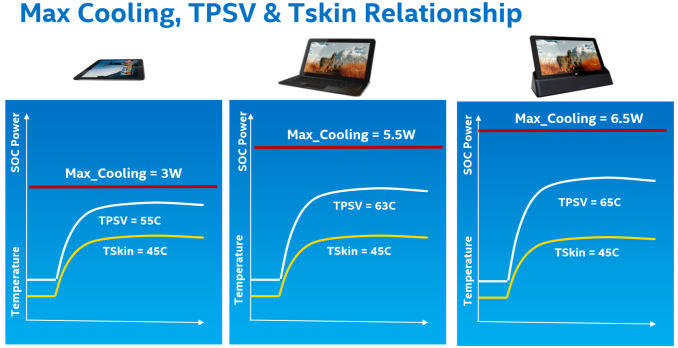
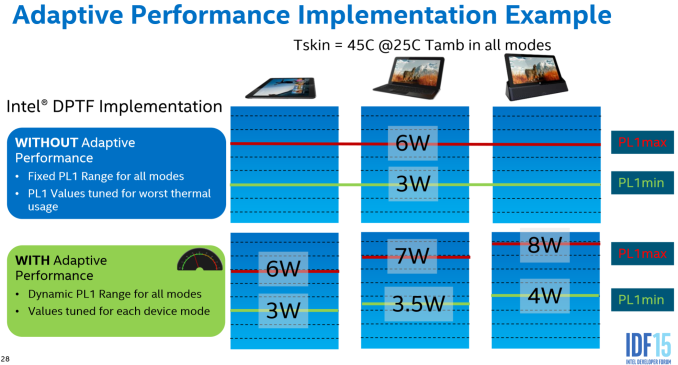
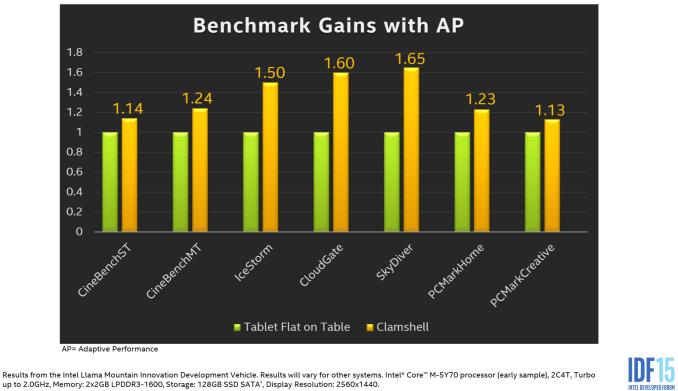
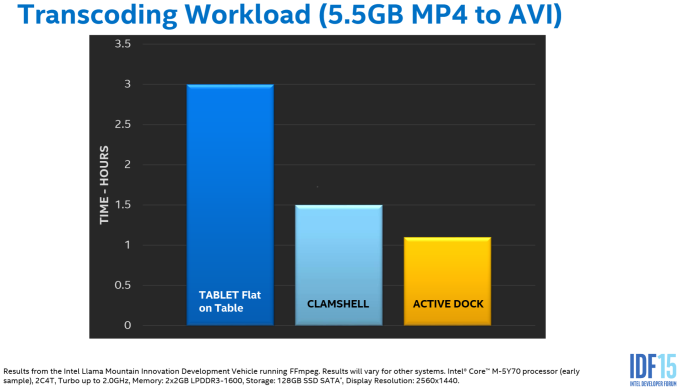








32 Comments
View All Comments
melgross - Sunday, August 23, 2015 - link
Since when have OEMs making Windows devices ever made lucrative profits? Mostly, they just barely make any profit.stephenbrooks - Friday, August 21, 2015 - link
--[I cant imagine anything, that would cause OEMs to run even faster towards ARM based Chromebooks, than Microsoft and Intel working closely together on a Surface device.]--These aren't even in the same market segment. Surface is as powerful as a good laptop and priced to match, Chromebooks are designed to be a cheap computer-like device. Surface is based around x86 software, Chromebooks use web-based software. I can't really see one replacing the other any more than an 10" Windows Atom netbook would replace a 15" OS X Mac Pro laptop or vice versa.
zodiacfml - Friday, August 21, 2015 - link
This isn't clear to me. Yes, it is true that performance will be better in some orientations but isn't it almost useless to discuss as throttling kicks in once the temperature threshold is reached set by the manufacturer and regardless of external factors?What we are missing here, I think, is the device surface temperature. For a 2 in 1 not attached to a dock/keyboard, it can be assumed that it is held by hand or flat on surface so its thermal performance should be limited to avoid user discomfort with higher temperatures.
I think what Intel is trying to fix here is a device similar to the Yoga 3 Pro where the thermal limits is static where the thermal headroom is too safe, targeting the low surface temps. Where, it should be able to increase that limit when it detects an orientation such as the laptop or tent mode as it is not held by a user.
Mushkins - Friday, August 21, 2015 - link
The problem with that is how these devices go from mobile to standing and back very quickly by design. To take my SP3 on the go I literally pick it up and pop the kickstand in, a process that takes two seconds tops.If you let it get too hot even when free standing, it'll take about a day before someone goes to grab it and it burns their hand followed by a juicy lawsuit and an expensive hardware recall.
mkozakewich - Friday, August 21, 2015 - link
Even at 60°C, it takes a few seconds for any kind of skin damage to take place. You can hold something at 50°C for a couple minutes. When they're setting maximum skin temps at 45°C, it's because they don't want people to feel uncomfortable at all.Personally, I'd like power profiles in more operating systems, and for those profiles to actually do something with the max temperatures or minimum clock cycles or stuff like that.
JoshHo - Monday, August 31, 2015 - link
It's important to understand that the reaction of the system to these changes is effectively instant and that skin temperatures are usually set to the same limit for all modes of operation. If you were to place the tablet on a table it would immediately change state to handle the difference.azazel1024 - Friday, August 21, 2015 - link
Power draw does not increase with the square of the frequency, it is a linear response. It increases with the square of the VOLTAGE. However, to hit certain frequencies, you may have to increase voltage, which has the double whammy of increased voltage and frequency for power consumption.Moving from 2GHz to 2.2GHz should only result in an increased power draw of 10%. However, if you also have to increase voltage from 1 to 1.1v to get 2.2GHz, you increase power consumption by a further 21% at that frequency. So you have a total increase of 33%. This is why voltage scaling can be a good thing (if you can decrease it) and a bad thing (if you must increase it).
JoshHo - Friday, August 21, 2015 - link
Yes, this is true. The relationship is more complex than described, but for the purposes of understanding why power increases don't directly translate to linear clock gains the explanation is sufficient, although I'd be happy to know why this isn't the case.extide - Friday, August 21, 2015 - link
Funny, I have noticed the press (not sure if it was AT or another site) making this mistake several times recently. Kinda weird. But yeah, everything the parent of my post said is correct.WagonWheelsRX8 - Friday, August 21, 2015 - link
Why don't they just attach a few sensors to the chassis and measure the skin temperature directly? No guesswork needed, and those sensors aren't that big.